The historical Buddha Siddhartha Gautama, or Sakyamuni, passed away around the fifth century BC. Later, the Indian emperor Ashoka the Great (304 – 232BC) of the Mauryan Dynasty dispatched Buddhist monks to spread the religion beyond the empire, which had a huge impact throughout the Asia region (photo 1).
During the early years of Buddhism, idol worship was forbidden, and it wasn’t until later, when Greek anthropomorphic concepts influenced Buddhist statues, that Buddhist art developed different styles and an iconological vocabulary of its own (for the Hellenistic Gandharan style of Buddhist statuary, see Bilingual Arts on July 27).
Following the transmission of Buddhism to China via the Silk Road, there was a significant transformation in Buddhist statuary and figurative representation. In Chinese painting there is the twin concept of 吳帶當風、曹衣出水 (“Wu’s strands flapping in the wind, Cao’s clothes from the water”), in which the 吳, wu, of the first phrase referred to the Tang Dynasty painter Wu Daozi (685 – 758AD) — known as the “sage of painting” — while the 曹, cao, of the second refers to the Buddhist figurative artist Cao Zhongda (dates unknown) of the Northern and Southern dynasties period.
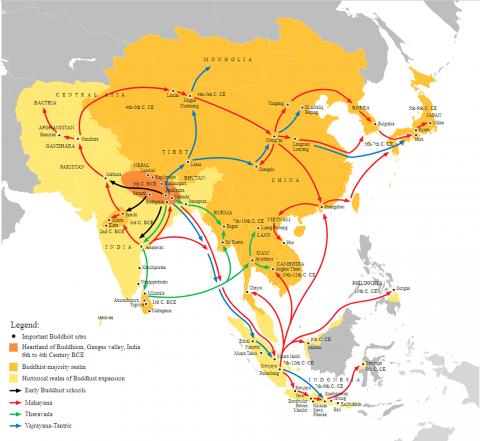
Photo: Wikimedia Commons
照片:維基共享資源
Wu’s figurative representations were said to depict clothes billowing in the wind, using flowing lines. No actual examples of Wu’s work survive, but see Bilingual Arts on Sept. 30, 2017 for an introduction to examples of Wu’s painting style in the Dunhuang Mogao Caves.
Cao was from a state in Central Asia, in the present day region of Samarqand in Uzbekistan. He was renowned for his figurative paintings and Buddhist statuary dating to the Northern Qi Dynasty (550 – 577AD). Cao used dense, fine lines to depict figure-hugging clothing, revealing the shape of the torso beneath, as if the person had just emerged from water.
In the tuhua jianwen zhi (Record of Illustration and Traditional Chinese Painting) by Northern Song Dynasty art connoisseur Guo Ruoxu, Guo writes: “under Wu’s brush, clothing is depicted in strong, rounded strokes, fluttering in the air; Cao builds up the clothing with dense, tight lines. Thus, their work was later described as ‘Wu strands in the wind, Cao clothes from the water.’ Indeed, sculpture and statuary started with Cao and Wu.” Guo’s words show us the extent to which the figurative styles of Wu Daozi and Cao Zhongda were to influence Chinese painting and sculpture.

Photo: Pixabay
照片:Pixabay
Unfortunately, painting and calligraphy are fragile, and few examples survive the ravages of time. Also, in antiquity, the work of sculptors was anonymous. As a result, we cannot attribute any works to Cao Zhongda per se. Nevertheless, in the extant Buddhist statuary datable to the Northern dynasties, we can still distinguish his style in the Buddhist Caves at Yungang (photo 2), which were clearly influenced by the Gandharan style.
From the Gandharan-influenced style to Cao’s legacy and the lively depictions of Wu, we can see the line of stylistic development of Buddhist statuary, and how Buddhism itself was influenced by its new home.
(Translated by Paul Cooper, Taipei Times)
釋迦牟尼約西元前五世紀寂滅後,佛教經孔雀王朝阿育王(西元前三○四~前二三二年)派遣僧侶大力對外傳播,影響力擴及亞洲各地。【圖一】
而視覺上的佛教,則由初始的禁止偶像崇拜,經希臘的「人神同形同性」概念賦予形象、造出佛像後,演變出許多不同的風格及圖像學語彙。(關於希臘化的犍陀羅式佛像,請參見七月二十七日的「雙語藝術」單元。)
佛教經絲路傳到中國後,也對佛像及人物形象的塑造有很大影響。中國繪畫中有「吳帶當風」、「曹衣出水」這樣的一組對照概念。「吳帶當風」的「吳」,指的是被尊稱為「畫聖」的唐代畫家吳道子(西元六八五~七五八年),其人物塑造,以流轉的線條營造出衣帶飛動轉折的飄逸形象。(吳道子作品真蹟現已不存,但可參見二○一七年九月三十日「雙語藝術」所介紹吳道子風格的敦煌壁畫。)
「曹衣出水」的「曹」,指的則是南北朝時期的梵像家曹仲達(生卒年不詳)。曹仲達來自中亞的曹國(今烏茲別克撒馬爾罕一帶),為北齊(西元五五○年~五七七年)製作了許多人物畫及佛教塑像,享有盛名。曹仲達以稠密的細線表現衣服褶紋貼身透明,人物軀體隱隱若現,像是剛自水中而起,故稱「曹衣出水」。
北宋藝術鑑賞家郭若虛的《圖畫見聞志》即說道:「吳之筆,其勢圓轉,而衣服飄舉;曹之筆,其體稠疊,而衣服緊窄。故後輩稱之曰:『吳帶當風,曹衣出水』」,且「雕塑鑄像,亦本曹、吳」,說明了曹仲達與吳道子的人物造型方法對中國繪畫及雕塑的影響。
由於書畫的易毀壞性,以及古時雕塑工匠皆不署名,因此並無已知之曹仲達作品傳世,但從現存的北朝佛教造像中,仍可看出類似「曹衣出水」的風格(例如開鑿於北魏的雲岡石窟,【圖二】),而這明顯來自犍陀羅的影響。
由犍陀羅到「曹衣出水」的身體量感,乃至「吳帶當風」的昇騰靈動,我們可以看見佛像風格互相發明的演變,以及佛教的在地化。
(台北時報林俐凱)
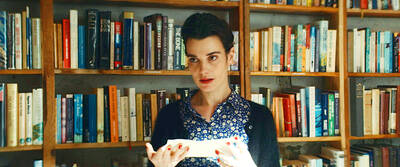
A: In addition to “Mission: Impossible 8,” what other new movies are in theaters? B: “Final Destination: Bloodlines” and “The Wedding Banquet” are out. The French film “Jane Austen Wrecked My Life” will also open soon. A: The Final Destination horror movie series is so scary that I don’t dare watch it. B: Then how about “The Wedding Banquet,” which is a 2025 remake of the 1993 classic of the same title? Oscar-winning actress Youn Yuh-jung’s performance in it is highly anticipated. A: But as a fan of British writer Jane Austen, I’m more interested to see how her works
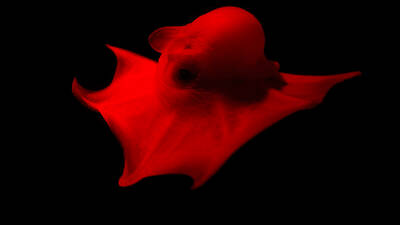
The deep waters off the coast of California are home to a bizarre creature: the flapjack octopus. This creature, known for its pancake-like appearance, spreads itself thin on the seabed as a clever survival strategy, making it difficult for predators to spot and capture it. With its unique, umbrella-shaped body formed by webbed arms, the flapjack octopus moves through the water in a graceful manner. It propels itself forward by rhythmically moving its body and contracting its webbed arms. Its pair of ear-like fins, which move independently yet with remarkable coordination, also help it explore the deep-sea environment. These
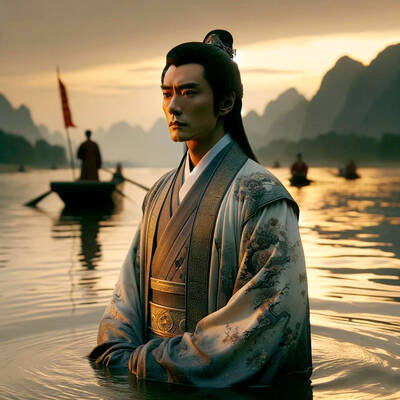
Bilingual Story is a fictionalized account. 雙語故事部分內容純屬虛構。 I stand by the Miluo River as dusk falls. The court betrayal is too much. I served Chu with loyalty. I forged alliances and fought corruption. But the whispers of jealous courtiers, the murmurs of treason, spoke louder. The king cast me out. The water looks calm. It promises peace. I step in. The river is cold against my legs. I hear shouts behind me — fishermen calling my name. I keep walking. The calls grow louder, but I do not turn around. The water rises to my chest. It pulls at me. I
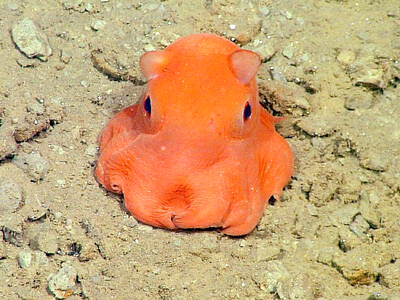
Continued from yesterday(延續自昨日) https://www.taipeitimes.com/News/lang Many people may be familiar with flapjack octopuses thanks to Pearl, a charming character from the Pixar film Finding Nemo. However, her portrayal presents several scientific inaccuracies. In reality, flapjack octopuses are deep-sea creatures, which are unsuitable for the brightly lit shallow reef environment depicted in the film. Their primary defense mechanism relies on their reddish coloration, which would be ineffective in the well-lit shallows. Pearl’s famous line, “You guys made me ink,” is another fictional detail that is not consistent with the observed actions of real flapjack octopuses. As common as it is in many other octopus